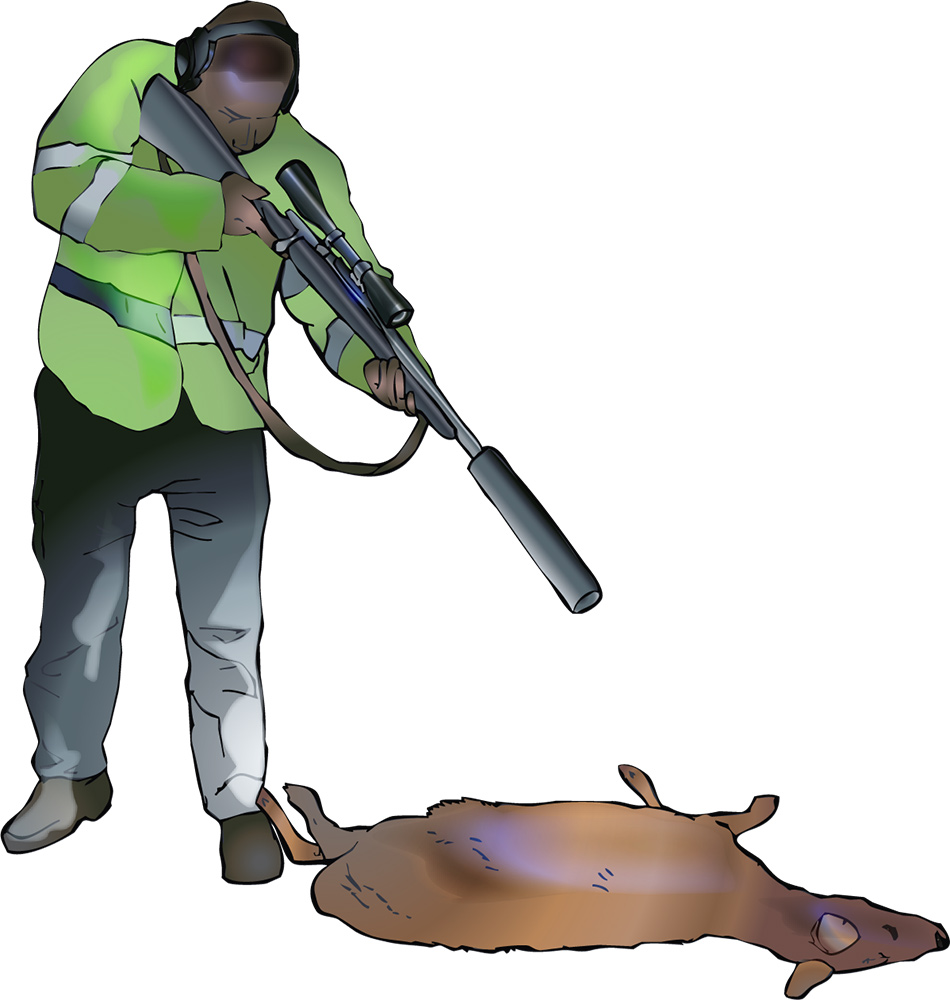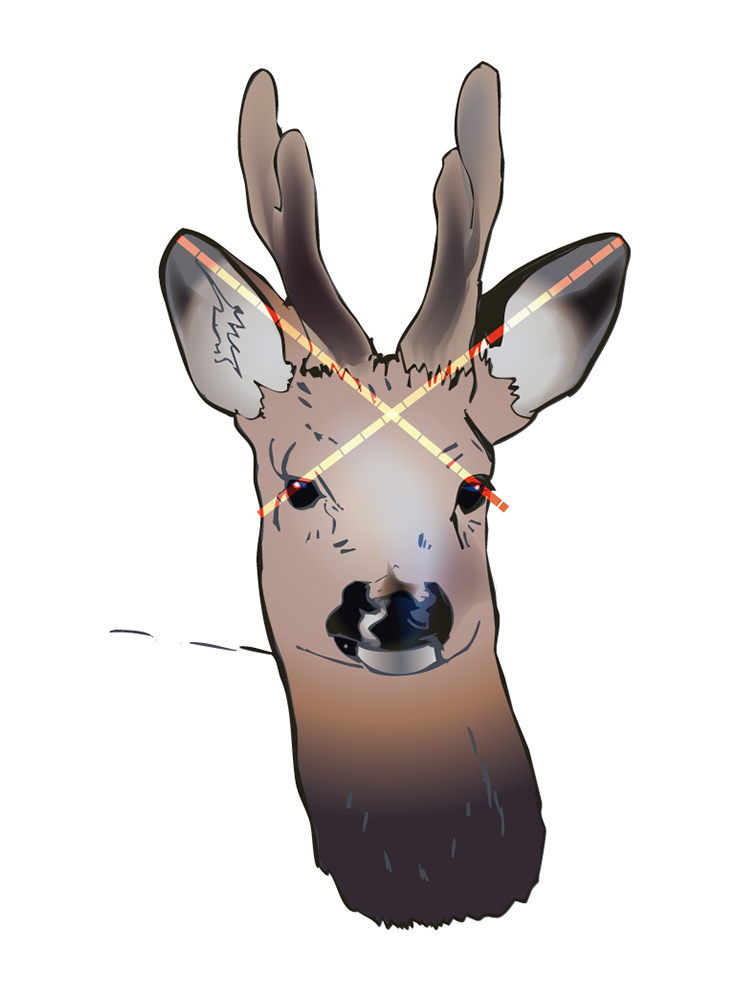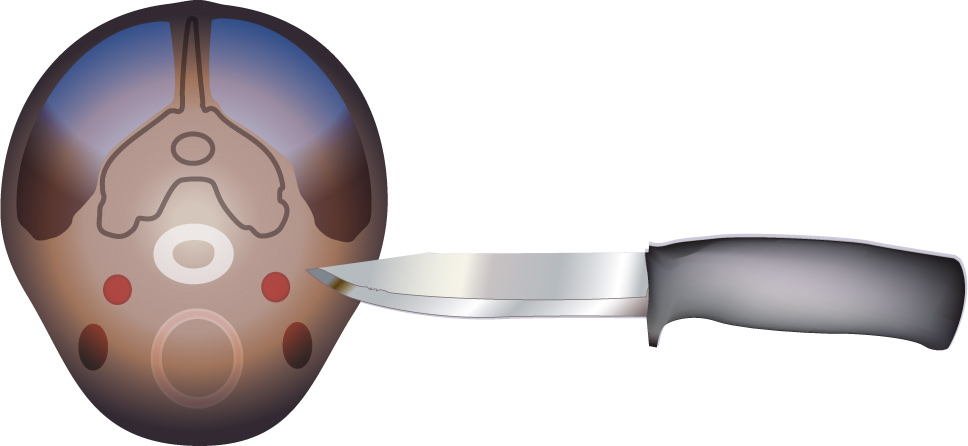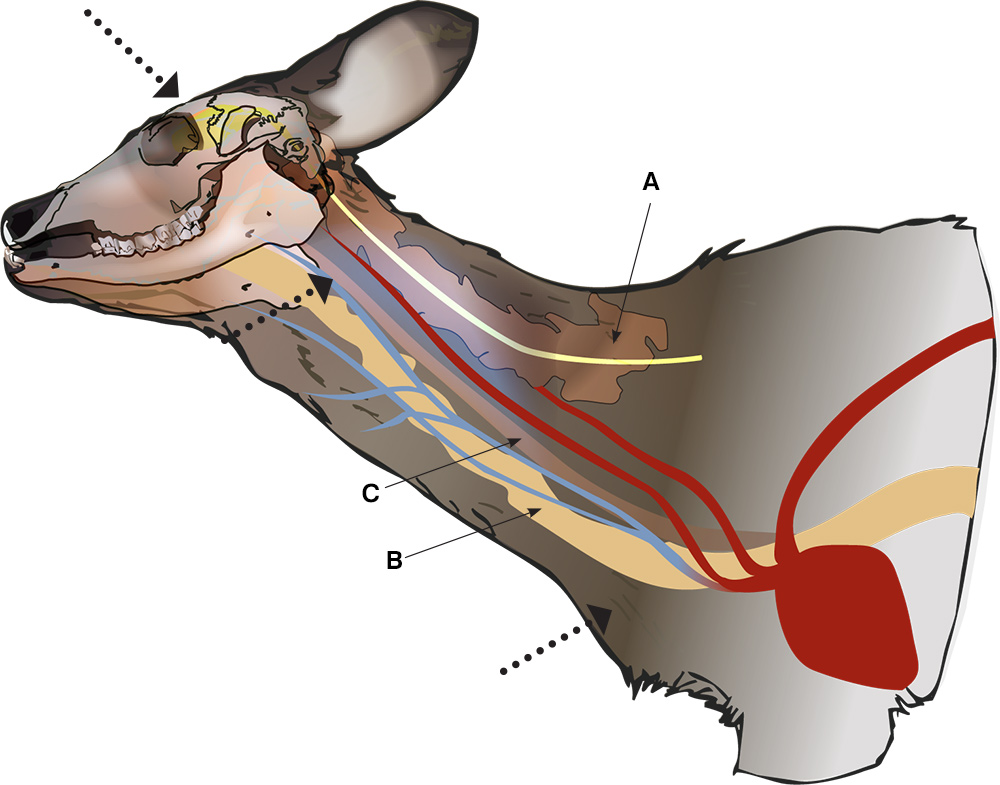
Ensure there is a safe background
Introduction
At least 74,000 deer are injured on roads in the UK each year. Many are killed, some disappear to die later, but a significant proportion are injured and remain alive at the scene. Such animals may suffer badly and are a potential further hazard to road users. Often the only reasonable course is to humanely dispatch the animal as soon as it is safe to do so.
This guide describes how to cope with injured deer at the roadside in a humane, safe and legal manner and is relevant to members of humane dispatch schemes as well as to individuals who occasionally have to deal with deer vehicle collisions(DVCs).
This guide links to Shooting Deer and By-product Disposal guides.
Humane dispatch Schemes
In some areas there may be schemes designed to cope with DVCs. Usually such schemes are coordinated by the Police who may call on nominated individuals either to assist at an incident or to take responsibility at an incident of which the Police have been advised. Volunteers are usually required to have:
- the necessary experience and/or qualifications and training to deal with an incident in an efficient, safe, humane and legal way. Specialist training is occasionally available and qualifications such as Deer Stalking Certificate level 2 indicate some experience in culling deer.
- firearms and certificate conditions to allow for humane dispatch of deer
- the means and desire to be able to reliably respond to a call out as agreed
- adequate means of communication from remote places e.g. mobile phone
- adequate insurance providing third party cover
- a legal means of carcass disposal if required by the scheme
Volunteers are not usually paid for attending but safety equipment and/or training may be provided in some cases.
Planning
Whatever the reason for your presence in the first place, each incident needs to be dealt with in a manner designed to protect human safety first, then reduce the suffering of the animal. Planning for an incident will save time and make you more efficient on arrival.
Equipment
If you expect to be regularly called out to deal with DVCs then permanently equipping your vehicle or assembling a “grab bag” with all of the equipment you expect to need is a good idea. Firearms and ammunition, of course, will need to be collected from secure storage as required (see Choice of Method below for list of suitable firearms).
The equipment list (excluding firearms ) might include:
- Hi-vis clothing, yellow (at least a class 3 long sleeved hi-vis jacket with reflective tape)
- Roadside hazard warning triangles for vehicle
- Powerful torch
- Knife with locked or fixed blade of 5”(12cm) or so long*
- Means of lifting heavy carcass
- Vehicle for carcass transport and safe storage of firearms
- Map or GPS unit to pinpoint carcass for records/pick up by local authority
- Recording/reporting forms and pen
- Mobile phone or other means of communication
- * attending a DVC would be considered by Police a reasonable excuse to carry such a knife.(Criminal Justice Act 1988 ,Violent Crime Reduction Act 2006)
The call out
You may be informed of a DVC by the Police, a third party or come across an incident yourself. If you were not called out by the Police it is always advisable to inform them and to ask for an incident number before attending, this may be a requirement of some DVC schemes.
Location and other information
Much time can be wasted if the location of the incident is unclear. A map or GPS reference is preferable but more often you will have to rely on as detailed a description as you can get. Be prepared to ask detailed questions such as which deer species and how many animals are involved and whether the animal(s) are alive. The information provided may help you to decide on the appropriate equipment to take, and how you plan to tackle the incident.
On arrival – Actions before dispatch
Having made certain of your own safety and that your vehicle is in a safe place and if necessary in a position that will protect you when working, you will have to rapidly assess the following factors:
- Safety of other road users and potential dangers from traffic
- Presence of onlookers and how to explain what is happening and keep them clear
- If Police are present, decide who will take charge (Police may have a view on the method of dispatch but should allow you to make the final decision and carry it out)
- Whether assistance is needed
- Location of deer on highway, verge or adjacent land
- Status of deer( how many, alive, dead, mobile, incapacitated) and is a quick recovery likely (there is a general presumption that any deer involved in a DVC, especially if immobile at the scene, will not recover)
Your plan for safe dispatch including safe background and hearing protection if firearms are to be used. - Your plan for removal/disposal of carcass
- Other complications due to the situation
In certain situations you may decide that nothing can be done because it would endanger yourself or others in which case inform the Police and those present explaining why.
The condition of the injured animal is a major consideration when planning and carrying out humane dispatch. Often the first consideration is that the deer may be a hazard to yourself or others, especially other road users.
Dead deer are straightforward to deal with as long as they are not too heavy to move. If they are on the carriageway they should be removed to the verge provided it is safe to do so.
Mobile deer may have to be encouraged into a safe area before deciding what to do. If dispatch is necessary it may not be possible to get close to the animal, a rifle or shotgun may have to be used at other than very close range in which case extreme care should be taken to ensure a safe shot. If the injured animal runs from the road and onto private land all reasonable efforts should be made to consult the landowner as to their preferred course of action. Without permission there may be a claim of trespass, regardless of motive, this could be particularly serious if a firearm was involved. Acting on a request from the police may provide reasonable excuse. If an injured animal disappears into cover the use of a trained dog on a leash should be considered and again the landowner must be consulted. In any case you should not move any carcass without the owner’s consent.
Immobile live deer may have to be moved to a safe area before dispatch but this should be done with the minimum of stress to the animal.

Ideal head shot placement.
(above) From the front the point of aim is at the crossing point of two imaginary lines drawn from the middle of each eye to the top of the opposite ear i.e. high on the forehead. The angle of shot follows down through the brain stem and spinal column. Shots from other angles should be aimed to do maximum damage to the brain and brain stem. Avoid hitting antlers/pedicles.
Humane dispatch
The method that you chose will depend on the situation. Legally any method is acceptable to prevent suffering provided that that it brings about a quick death, is appropriate to the circumstances and that to kill the animal would be an act of mercy. There are however, preferred methods for deer which are listed in Table 1. Note that for firearms the preferred point of aim is the head, from the front, at the intersection between two lines drawn from the eye to the top of the opposite ear. If it is possible to angle the shot through this point of aim and then into the neck and body this will provide an additional safe background for a bullet. Often it may not be possible to obtain a frontal shot but the brain, which is high in the head of deer should still be the target (see Table 1).
Both the rifle and 12 bore shotgun with AAA or larger shot have the advantage that they can be used if a previously immobile animal moves further away or cannot be approached closely, this is not the case with other methods. Small shotgun shot (to be used only at very close range) tends not to exit the skull thus lessening ricochet risk in restricted areas.
Firearms must be kept secure at all times. When using firearms on or over rights of way or near buildings you must do so without committing the offences of trespass with a firearm, or possessing a firearm and ammunition with the intent to endanger life (Sec 16 Firearms Act 1968). It is an offence without lawful authority or excuse to discharge a firearm within fifty feet of the centre of a highway and in consequence of which a user of the highway is injured, interrupted or endangered(sec 161 Highways Act 1980). A request from the police to attend and deal with a DVC should ensure that both lawful authority and excuse exist. Obtaining an incident number while part of a police approved scheme may give similar reassurance.
| Method | Point of aim | Min/Max range | Comments |
|---|---|---|---|
| Deer legal rifle | Head, otherwise chest | Min 5cm, Otherwise as close as is comfortable, preferably not more than 5 metres | N.B. if using telescopic sights at short range the bullet will strike up to 5cm below the point of aim, you must compensate for this. Protect hearing of self and others. Ensure safe background. |
| Shotgun (.410 -12 bore, any shot size) | Head | Min 5cm, Max 20cm | Do not allow muzzle to make contact Protect hearing of self and others. Ensure safe background. |
| Shotgun ( Min 12 bore with AAA or larger shot) | Preferably head, otherwise head/neck | Min 20 cm, Max 10 metres for sika, fallow and red. Max 25 metres for smaller dee | Do not allow muzzle to make contact Protect hearing of self and others. Ensure safe background |
| Rimfire rifle | Head | Min 5 cm, Max 20cm | Protect hearing of self and others. Ensure safe background. |
| Free bullet pistol (unmodified) | Head | Min 5 cm, Max 20cm | Protect hearing of self and others. Ensure safe background. |
| Pistol modified as slaughtering instrument | Head | Contact with skull or max 5cm | May not be appropriate with large antlered deer due to risk to user. Protect hearing of self and others. Ensure safe background |
| Captive bolt plus “pithing” or bleeding with a knife | Head | Contact with skull | A captive bolt only stuns, pithing* or bleeding is required to ensure death. May not be appropriate with large antlered deer due to risk to user. |
(re above) Occasionally a firearm may not be available or appropriate. In such situations a knife could be used, this requires training and/or experience to carry out effectively. The minimum requirement is a very sharp blade, at least 12 centimetres (5 inches) in length. The aim is to cause rapid blood loss and the preferred method is to use thoracic sticking by pushing the knife in just above the sternum at the base of the neck and working it from side to side to cut the blood vessels above the heart. If this is not possible cut the carotid and jugular blood vessels in the throat directly below the jawbone by driving the point of the knife through both sides of the neck against the neck bone and then cutting outwards to the front of the throat. Whichever method is used take care to control the head especially with antlered deer. *pithing involves the use of a special rod which is passed through the hole made by the captive bolt, out through the base of the skull and into the spinal nerve, and worked backwards and forwards to destroy the nerve tissue

knife is pushed in here and then out through front of throat
(above) central pale ring is oesophagus; the pair of red dots immediately below are the carotid arteries and below these are two more red dots representing the jugular veins; the trachea is the pale circle below oesophagus

use of knife. Preferably use thoracic sticking at base of neck, if this is not possible cut both carotid arteries and both jugular veins just behind the jaw. The knife needs to be very sharp and at least 120mm (5 inches) long
(above) line of shot straight down through brain stem; A is the neck vertebrae, B the trachea, C is the oesophagus; red represents heart and carotid arteries; blue is the jugular veins and the yellow line in neck vertebrae is the spinal cord.
Removal of carcass
First, the carcass must not present a danger to road users. It is the responsibility of the Police to maintain road safety but simply moving the carcass off of the carriageway will help. Carcasses on the side of the road are the responsibility of the Highways Authority, or the Local Authority who should be informed, giving a precise location, if you are unable or unwilling to dispose of the carcass yourself. If other landowners are involved their permission should be sought. Road accident carcasses are not permitted to go into the food chain so disposal will have to be by approved means ( see By-product Disposal guide)
If a vet has attended the scene and administered a lethal injection the vet must ensure that the carcass is disposed of by approved means.
Personal hygiene
Deer involved in collisions are often badly damaged or may be diseased. You should take sensible precautions when handling them and ensure that any equipment is cleaned before being used for other carcasses.
Bio-security
If you are dealing with DVCs during an outbreak of a notifiable disease such as Foot and Mouth there may be restrictions on what you can do and you may have to employ strict bio-security measures. Advice will be found on the Deer Initiative and DEFRA websites.
If you suspect a notifiable disease inform the relevant authorities.
Notification and records
For each DVC that you attend it is advisable to keep a record which should include:
date
location (preferably a 6 figure map reference)
a Police incident number( obtainable from the local control room)
details of injured deer
means of dispatch
means of disposal
any other relevant information
This may be a requirement of your humane dispatch scheme but in any case passing the location and deer details on to such schemes as the Deer Initiative Deer Collisions Project will add to national data on such incidents.
Insurance
Attending a DVC could potentially give rise to a legal liability claim as a result of negligence.
Both the BASC and BDS have insurance schemes for members dealing with DVCs.
The BASC policy covers members in the normal course of their (recreational) activities, including if they are called out by a third party but excluding work related or commercial activities. Members must register their intent to make use of the insurance.
BDS members can purchase insurance which covers call outs to DVCs, again, work related or commercial activity is excluded. In some cases members of approved schemes may be covered automatically when they obtain an incident number from the Police.
In all other cases appropriate cover will have to be arranged through an insurance broker.
Further Info
Road Traffic Accidents and the Humane Dispatch of Deer. BASC/BDS advice note
Membership insurance schemes – see BASC/BDS websites
DI deer collisions website – http://www.deercollisions.co.uk/
[printfriendly]